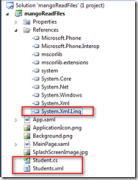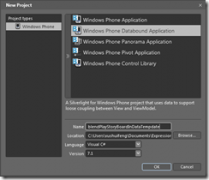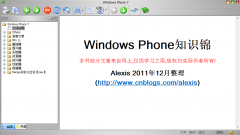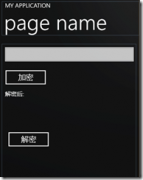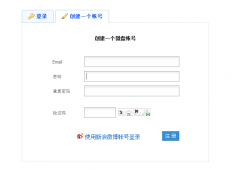Windows Phone 实用开发技巧(27):创建透明Tile
I have talked about how to create custom Live Tile in 《Windows Phone 实用开发技巧(17):自定义应用程序的Tile》. Today let’s dig a little bit deeper.
What do you see in this image shown below ? Do you see the same tile with different background called accent color in windows phone . So how can we create such tile . One simplest way is we replace ApplicationIcon.png with a transparent png file. But as we know it is just main tile of our app. Can we create own tile since we can pin what we want to start ? Yes, we can do that. All we need to do is to create a transparent png file and save it to Isolated. Maybe you have already know, we can save jpg file to Iso with following code: or But jpg can not be transparent. So we need some extra library to help us create transparent png images. Here I use the famous open souce ImageTools. We can use two differernt ways to dynamic create images. One way I have post here. Here is CreateBackground method looks like: Another way is just render it within ImageOpened event: I have a test on it(Conculsion is prefer to use second way as it’s faster and more stable! ) Tranditonal took 239 ms, Image size 6.11kb You can find demo source code here. Hope that helps, 
WriteableBitmap bit = new WriteableBitmap();
bit.SaveJpeg(stream, 480, 800, 0, 100);
Extensions.SaveJpeg(WriteableBitmap, stream, 480, 800, 0, 100);
//add encoder for png image Encoders.AddEncoder<PngEncoder>();
StandardTileData std = new StandardTileData {
BackgroundImage = new Uri(CreateBackground()),
Title = "Tile Test",
BackTitle = "Secondary",
BackBackgroundImage = new Uri(CreateBackground())
};
ShellTile.Create(new Uri("/MainPage.xaml?type=1", UriKind.Relative), std);
sw.Stop();
Debug.WriteLine("Tranditonal method took time :" + sw.ElapsedMilliseconds);
public static string CreateBackground()
{
Grid grid = new Grid {
Background = new ImageBrush {
ImageSource = new BitmapImage {
UriSource = new Uri("/mangTile;component/Images/1.png", UriKind.Relative),
CreateOptions = BitmapCreateOptions.IgnoreImageCache
}
},
Width = 173,
Height = 173
};
TextBlock tb = new TextBlock {
Text = "Hello world",
Foreground = new SolidColorBrush(Colors.Red),
FontSize = 32,
};
grid.Children.Add(tb);
grid.Arrange(new Rect(0d, 0d, 173, 173));
WriteableBitmap wbmp = new WriteableBitmap(grid, null);
ExtendedImage extendImage = wbmp.ToImage();
using (var store = IsolatedStorageFile.GetUserStoreForApplication())
{
if (!store.DirectoryExists(tiledirectory))
{
store.CreateDirectory(tiledirectory);
}
using (var stream = store.OpenFile(fullPath, System.IO.FileMode.OpenOrCreate))
{
extendImage.WriteToStream(stream, fullPath);
}
}
return "isostore:/" + fullPath;
}
And as we run it we can see what shown below:

public static void CreateTile(Uri imageUri, string temperature, string timeOfDay)
{
var source = new BitmapImage(imageUri)
{
CreateOptions = BitmapCreateOptions.IgnoreImageCache,
};
string fullPath = tiledirectory + @"/" + timeOfDay + ".png";
// This is important. The image can't be rendered before it's loaded. source.ImageOpened += (sender, e) =>
{
// Create our image as a control, so it can be rendered to the WriteableBitmap. var cloudImage = new Image { Source = source, Width = 173, Height = 173 };
// TextBlock for the time of the day. TextBlock tbTemperature = new TextBlock {
Text = temperature + '°',
FontSize = 36,
Foreground = new SolidColorBrush(Colors.White),
FontFamily = new FontFamily("Segoe WP"),
};
using (IsolatedStorageFile store = IsolatedStorageFile.GetUserStoreForApplication())
{
if (!store.DirectoryExists(tiledirectory))
{
store.CreateDirectory(tiledirectory);
}
var bitmap = new WriteableBitmap(173, 173);
// Render our background. Remember the renders are in the same order as XAML, // so whatever is rendered first, is rendered behind the next element. // Render our cloud image bitmap.Render(cloudImage, new TranslateTransform());
// Render the temperature text. bitmap.Render(tbTemperature, new TranslateTransform()
{
X = 124,
Y = 63
});
bitmap.Invalidate();
ExtendedImage extendImage = bitmap.ToImage();
using (var stream = store.OpenFile(fullPath, System.IO.FileMode.OpenOrCreate))
{
extendImage.WriteToStream(stream, fullPath);
}
StandardTileData std = new StandardTileData {
BackgroundImage = new Uri("isostore:/" + fullPath),
Title = "Tile Test22",
BackTitle = "Secondary",
BackBackgroundImage = new Uri("isostore:/" + fullPath)
};
ShellTile.Create(new Uri("/MainPage.xaml?type=2", UriKind.Relative), std);
}
};
}
Render took 10 ms, Image size 5.24kb.![]() .
.
本文出自 “Alexis的51博客” 博客,请务必保留此出处http://alexis.blog.51cto.com/2621421/706532
相关新闻>>
- Windows Phone 实用开发技巧(25):Windows Phone读取本地数据
- Windows Phone 项目实战之我的微盘(上)
- Windows Phone 项目实战之我的微盘(下)
- Windows Phone 实用开发技巧(26):对DataTemplate中的元素播放
- Windows Phone 实用开发技巧(28):图片缓存
- Windows Phone 实用开发技巧(29):动态绑定Pivot
- Windows Phone 实用开发技巧(30):Pivot切换时同时渐变背景图
- Windows Phone 实用开发技巧1-30合集(电子书+源代码)
- Windows Phone 知识锦(12月版)
- Windows Phone实用开发技巧(31):密码加密
- 发表评论
-
- 最新评论 进入详细评论页>>

